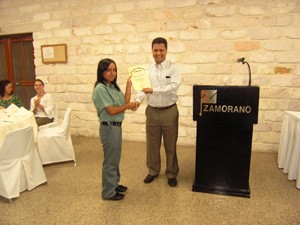
Yuri Tecún is an exception to the rule. Thanks to a USAIDbacked scholarship program, she was able to attend university, unlike many other young girls in Guatemala.
According to the 2002 census, only 2.87 percent of high school graduates in Guatemala go on to university. Girls make up only 1.26 percent of this group. If a girl happens to come from a lowincome, rural family like Yuri her chances are even lower.
Like most rural students here, Yuri attended a public high school with many limitations: her building was made with makeshift walls and a tin roof; classrooms flooded when it rained; and teachers and students lacked materials, including textbooks.
Nevertheless, Yuri made the Honor Roll every year and defied the odds when she won a USAID|Alianzas scholarship to attend Zamorano University in Honduras.
During her second year of Agronomy at Zamorano, she ranked seventh among 240 students from countries throughout Latin America. Yuri is not only excelling academically but has also taken on a leadership role by mentoring fellow students and fundraising for the Maternal-Child Hospital in Tegucigalpa. In her words, she wants to return a little of all she has received in life by giving some happiness to children in need.
She also expresses gratitude for the opportunities she has received through the scholarship program. “Thanks for believing in me and for making the difference for girls from rural areas, like me, who otherwise couldn’t make it to the university,” said Yuri.
USAID|Alianzas was started in 2005 in Guatemala to guarantee permanent full scholarships for students who otherwise could not afford to attend university. To date, 1,665 scholarships have been granted – 974 of which have gone to women. Rozzana Pappa, Zamorano’s elected representative, explained that the donor fund now stands at $1 million. The program and its partners certify that 75 percent will go to indigenous students from rural areas.







Comment
Make a general inquiry or suggest an improvement.